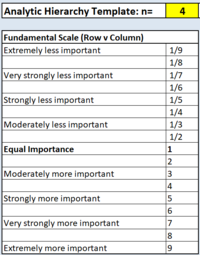Difference between revisions of "AHP s"
Jump to navigation
Jump to search
| (9 intermediate revisions by the same user not shown) | |||
| Line 1: | Line 1: | ||
| + | <!--Header--> | ||
| + | {|style="background-color:#14A9C6; color:#F5F5F5; padding: 10 0 10 0;" width="100%" cellspacing="0" cellpadding="0" valign="top" border="0" | | ||
| + | | style="padding:0.3em; font-size:100%; background-color:#14A9C6; text-align:center; color:#F5F5F5" width="10%" | [[SMT201 AY2019-19T1 EX2 Lok Ying Cheng Sheryee | | ||
| + | <font color="#F5F5F5" size=2><b>Overview</b></font>]] | ||
| + | |||
| + | | style="background:none;" width="1%" | | ||
| + | | style="padding:0.3em; font-size:100%; background-color:#14A9C6; border-bottom:0px solid #3D9DD7; text-align:center; color:#F5F5F5" width="12%" | [[Proximity_s | | ||
| + | <font color="#F5F5F5" size=2><b>Proximity</b></font>]] | ||
| + | |||
| + | | style="background:none;" width="1%" | | ||
| + | | style="padding:0.3em; font-size:100%; background-color:#14A9C6; border-bottom:0px solid #3D9DD7; text-align:center; color:#F5F5F5" width="12%" | | ||
| + | [[Criterion Score_s | | ||
| + | <font color="#F5F5F5" size=2><b>Criterion Score</b></font>]] | ||
| + | |||
| + | | style="background:none;" width="1%" | | ||
| + | | style="padding:0.3em; font-size:100%; background-color:#12BEC6; border-bottom:0px solid #3D9DD7; text-align:center; color:#F5F5F5" width="12%" | | ||
| + | [[AHP_s| | ||
| + | <font color="#F5F5F5" size=2><b>AHP</b></font>]] | ||
| + | |||
| + | | style="background:none;" width="1%" | | ||
| + | | style="padding:0.3em; font-size:100%; background-color:#14A9C6; border-bottom:0px solid #3D9DD7; text-align:center; color:#F5F5F5" width="12%" | | ||
| + | [[Suitability_s | | ||
| + | <font color="#F5F5F5" size=2><b>Suitability</b></font>]] | ||
| + | |||
| + | |} | ||
| + | <!--/Header--> | ||
| + | |||
= Analytical Hierarchical Process (AHP) = | = Analytical Hierarchical Process (AHP) = | ||
<div class="center" style="width: auto; margin-left: auto; margin-right: auto;">'''Pairwise Comparison'''</div> | <div class="center" style="width: auto; margin-left: auto; margin-right: auto;">'''Pairwise Comparison'''</div> | ||
| + | Analytic Hierarchy Process (AHP) is one of Multi Criteria decision making method to derive ratio scales from paired comparisons. The input can be obtained from actual measurement, or from subjective opinion. AHP allow some small inconsistency in judgement because human is not always consistent. | ||
| + | |||
[[Image:AHP 2.PNG|200px|centre]] <br> | [[Image:AHP 2.PNG|200px|centre]] <br> | ||
[[Image:AHP 1.PNG|600px|centre]] | [[Image:AHP 1.PNG|600px|centre]] | ||
| + | The AHP Template provided by SCB Associates have been used for pairwise comparison matrix.<br><br> | ||
| + | |||
| + | Based on the fundamental scale, I have ranked the different factors: 'Economic', 'Accessibility', 'Health Risk' and 'Natural Conservation' accordingly. | ||
<br> | <br> | ||
| Line 8: | Line 40: | ||
<div class="center" style="width: auto; margin-left: auto; margin-right: auto;">'''Consistency Check'''</div> | <div class="center" style="width: auto; margin-left: auto; margin-right: auto;">'''Consistency Check'''</div> | ||
[[Image:AHP 3.PNG|300px|centre]] | [[Image:AHP 3.PNG|300px|centre]] | ||
| + | The result have shown my ranking as follows:<br> | ||
| + | 1. Health Risk <br> | ||
| + | 2. Economic <br> | ||
| + | 3. Accessibility <br> | ||
| + | 4. Natural Conservation <br> | ||
Latest revision as of 03:09, 12 November 2019
| Overview | Proximity |
Analytical Hierarchical Process (AHP)
Pairwise Comparison
Analytic Hierarchy Process (AHP) is one of Multi Criteria decision making method to derive ratio scales from paired comparisons. The input can be obtained from actual measurement, or from subjective opinion. AHP allow some small inconsistency in judgement because human is not always consistent.
The AHP Template provided by SCB Associates have been used for pairwise comparison matrix.
Based on the fundamental scale, I have ranked the different factors: 'Economic', 'Accessibility', 'Health Risk' and 'Natural Conservation' accordingly.
Consistency Check
The result have shown my ranking as follows:
1. Health Risk
2. Economic
3. Accessibility
4. Natural Conservation


